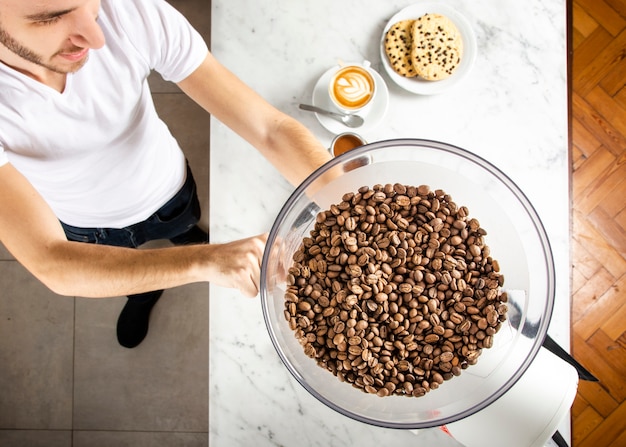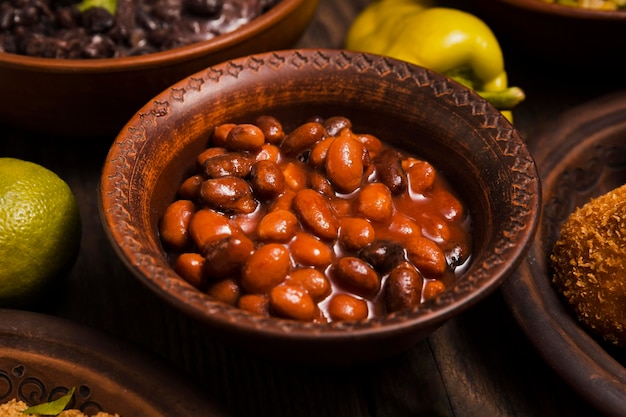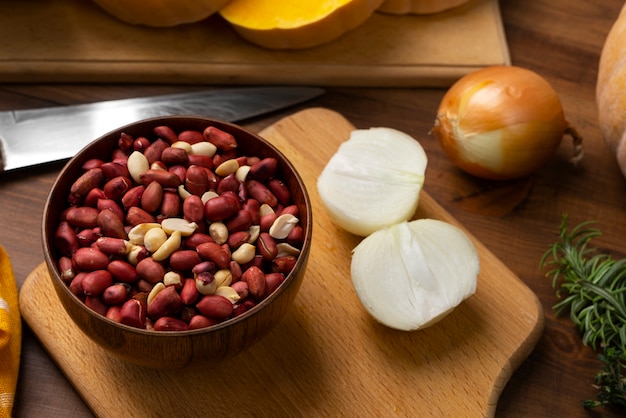Ah, beans. They’re a culinary chameleon, capable of transforming themselves into a hearty stew, a vibrant salad, or a creamy dip. But let’s be honest, no one wants to bite into a bean that's still a bit crunchy – it's like a culinary faux pas. So, I've been on a mission to conquer the art of cooking perfect beans, and I’m sharing my hard-won wisdom with you.
Part 1: Setting the Stage for Success: The Essentials of bean cooking

cooking beans is all about time and patience. It’s not a quick fix, but trust me, the reward is worth it. Imagine it like this: It's a slow-burning love affair with your beans. You’ve got to give them time to simmer, to soften, to release their rich flavours and become gloriously tender.
1. Soaking: The Foundation for Tender Beans
Soaking your beans is absolutely crucial. It's like a long, luxurious bath for your beans, allowing them to rehydrate and soften. Not only does it shorten the cooking time, but it also makes them easier to digest. Trust me, your gut will thank you for it!
Most beans need a good 6-hour soak, but some, like black beans, benefit from an overnight soak. Personally, I usually soak mine in a large bowl filled with cold water. You'll hear some folks swear by soaking in hot water, but I haven't found it necessary.
There’s also the “quick soak” method for beans. You bring the beans and water to a boil, then turn off the heat and let them soak for an hour. It's a decent shortcut, but I find the flavour a little less intense compared to a longer soak.
2. The Magic of Salt: Unleashing Flavour
Salt is a bean's best friend, but timing is key. Adding salt at the beginning actually draws moisture out, preventing those beans from getting nice and tender. Hold off on the salt until the beans are nearly cooked through, and then just a pinch will do. The salt will enhance their natural flavours and create a truly satisfying dish.
3. Choosing the Right Pot: A Home for Your Beans
Select a pot that comfortably accommodates your beans, with plenty of room for the water to dance around. I usually opt for a heavy-bottomed pot, like a dutch oven, because it distributes heat evenly. This helps prevent those pesky beans from sticking to the bottom and ensures they cook evenly.
Part 2: Decoding Cooking Time: How Long to Simmer Those Beans

Now, let's talk about how long those beautiful beans need to cook. It's all about the type of bean and your desired texture. Once you've mastered the basics, you'll get a feel for how long each variety needs.
1. The Bean Cookbook: A Guide to Cooking Times
Here's a handy table to get you started. Remember, these are just guidelines. The actual cooking time can vary based on the freshness of the beans, your altitude, and how tender you like them.
| Bean Type | Soaking Time | Cooking Time |
|---|---|---|
| Black Beans | Overnight or 6 hours | 1-1.5 hours |
| kidney beans | 6 hours | 1-1.5 hours |
| pinto beans | 6 hours | 1-1.5 hours |
| Chickpeas | 6 hours | 1-1.5 hours |
| cannellini beans | 6 hours | 1-1.5 hours |
| Red Beans | 6 hours | 1-1.5 hours |
| butter beans | 6 hours | 1-1.5 hours |
| Lima Beans | 6 hours | 1-1.5 hours |
2. The doneness test: Checking for Perfect Texture
Don't be shy about giving those beans a good poke. To check for doneness, scoop out a few beans and mash them with a fork. They should be soft and creamy, with no trace of firmness. If they're still crunchy, give them a little more time on the stovetop.
If you're cooking beans for a recipe like chili or soup, you might want them a bit firmer, while for a dip or salad, you'll prefer a softer texture.
Part 3: Beyond the Basics: Elevating Bean Flavour

Now comes the fun part: unleashing your creativity. Beans are a blank canvas, waiting for your flavourful touch. Get ready to explore a symphony of spices, the power of vegetables, and the magic of herbs.
1. A Symphony of Spices: A World of Flavour
Experiment with spices to add depth and complexity to your beans. Cumin, coriander, paprika, garlic powder, and onion powder are some of my go-to spices. A pinch of cayenne pepper adds a subtle kick, while smoked paprika infuses a smoky, earthy aroma.
Don't add the spices too early, though. Let them dance around at the end of the cooking process, allowing them to infuse the beans without becoming bitter. This creates a harmonious balance of flavours.
2. The Power of Vegetables: Adding Depth and Nutrition
Vegetables not only enhance the flavour but also boost the nutritional value of your beans. Carrots, celery, onions, and garlic are classic additions, adding a sweetness and complexity. I love to throw in some diced tomatoes for a touch of tanginess.
Add vegetables towards the end of the cooking process so they soften without becoming mushy. They'll release their flavours and create a truly delicious dish.
3. A Dash of Umami: A Final Touch of Flavour
For a burst of savoury umami, consider adding a tablespoon of soy sauce or fish sauce to your beans. It’s like a final flourish, complementing the spices and creating a truly satisfying taste.
4. The Magic Touch: Fresh Herbs
Fresh herbs like parsley, cilantro, or basil add a vibrant touch to your beans. Think of them as the finishing touch, bringing a fresh, bright flavour to the table. Add them at the end of the cooking process to preserve their beautiful freshness.
Part 4: Storing and Reheating: Keeping Those Beans Delicious
You've put in the time and effort, and now you have a pot of delicious, perfectly cooked beans. But what do you do with all that goodness?
1. The Storage Secret: Keeping Those Beans Fresh
Store your leftover beans in an airtight container in the refrigerator for up to 5 days. Let them cool down completely first to prevent any bacterial growth.
2. Reheating Magic: Bringing Back the Flavour
When you're ready to enjoy your beans again, gently reheat them on the stovetop or in the microwave. I prefer the stovetop method as it allows the flavours to meld together, creating a more cohesive dish. Just add a splash of water to prevent them from drying out.
Part 5: The Versatility of Beans: A culinary adventure Awaits
Beans are truly the culinary chameleon. They can shine as the main event or play a supporting role, adding richness and texture to countless dishes.
1. Beans as the Main Event
Beans are capable of transforming into hearty and satisfying meals. Think of them as a blank canvas, waiting for your culinary creativity to take centre stage.
- Soup and Stew Stars: Beans are the perfect base for creamy soups and comforting stews. Combine them with vegetables, spices, and a little broth for a meal that's packed with flavour and nutrients.
- Salad Sensation: Add a punch of protein and fibre to your salads with a handful of beans. They pair beautifully with greens, corn, avocado, and a tangy vinaigrette.
- Burrito Builders: Beans are a staple in Mexican cuisine, adding heartiness and flavour to burritos, tacos, and enchiladas.
- Pasta Party: Elevate your pasta dishes with a creamy bean sauce. Combine cooked beans with garlic, olive oil, and lemon juice for a simple and satisfying sauce.
2. Beans in a Supporting Role
Beans can also add texture and flavour to other dishes.
- Chili Challenge: Beans are a classic ingredient in chili, adding a hearty base and absorbing all the delicious flavours.
- Dip Delight: Whip up a quick and easy bean dip by combining cooked beans with salsa, sour cream, and avocado. It's a perfect party appetizer.
- Spice Up Your Sides: Add beans to your rice or quinoa for a boost of protein and flavour.
- The Bread Buddy: Try adding a handful of beans to your bread dough for extra protein and a chewy texture.
Part 6: bean faqs: Answering Your Burning Questions
Now, let's address some of those common bean-related questions.
1. Can I use canned beans instead of dried beans?
Absolutely! Canned beans are a great time-saving option, but I recommend rinsing them well to remove any excess salt or preservatives before using them in your recipes. But for the best flavour and texture, I'd say dried beans are the way to go.
2. Why aren't my beans softening?
If your beans are still crunchy after the recommended cooking time, it could be a few things:
- The beans might be old. Fresher beans tend to cook faster.
- You might have added the salt too early, preventing them from softening.
- The water might not be boiling hot enough.
- You might be using a pot that's too small, preventing even cooking.
3. What if I accidentally overcooked my beans?
Don't worry! Overcooked beans are still edible. They might be a bit mushy, but they'll still work in most recipes.
4. Can I freeze cooked beans?
Yes, you can freeze cooked beans for up to 3 months. Just let them cool completely, then store them in an airtight container in the freezer. Thaw them overnight in the refrigerator before using them.
5. What are some good bean recipes for beginners?
Here are a few simple and delicious bean recipes:
- black bean salsa: A refreshing and flavorful salsa that's perfect for chips or as a topping for tacos.
- Three bean salad: A classic side dish that's packed with flavour and nutrients.
- Simple bean soup: A hearty and comforting soup that's perfect for a cold day.
Part 7: The Bean Revolution: Embracing a World of Deliciousness
I'm a huge advocate for beans. They're affordable, nutritious, and incredibly versatile. So, embrace the bean revolution and let them take centre stage in your kitchen. You won't regret it!
Part 8: A Final Word on the Art of Bean Cooking
The key to cooking perfect beans is patience and a bit of experimentation. Don't be afraid to try different recipes and techniques until you find what works best for you. And remember, there's no right or wrong way to cook beans, just a whole lot of delicious possibilities. So go on, embrace the bean journey, and discover the magic of these humble legumes!
Everyone is watching

Corn on the Cob: The Ultimate Guide to Perfectly Cooked Ears
Healthy MealsAh, corn on the cob. Just the name evokes images of sunny days, barbecues, and that sweet, juicy flavour that ...

Perfect Pork Roast Oven Cooking Time: A Guide to Delicious Results
Healthy MealsThere's something truly satisfying about a perfectly roasted pork. The aroma alone is enough to make your mout...

Scallops: The Ultimate Guide to Perfect Cooking
Healthy MealsAh, scallops. Those delicate, sweet, and utterly delicious morsels of the sea. They hold a special place in my...

Ham Cooking Time: How Long to Bake, Smoke, or Boil a Delicious Ham
Healthy MealsAh, ham. It's a classic, isn't it? A real crowd-pleaser, especially around holidays. And when done right, it'...

Spaghetti Squash: The Ultimate Guide to Cooking and Serving
Healthy MealsRemember that time you saw spaghetti squash at the supermarket, looking all bumpy and strange, and thought, "W...
